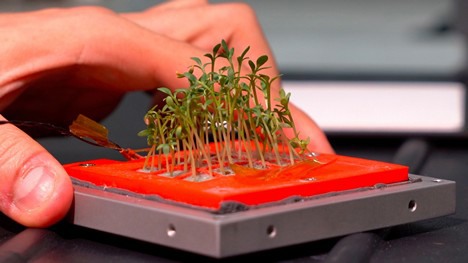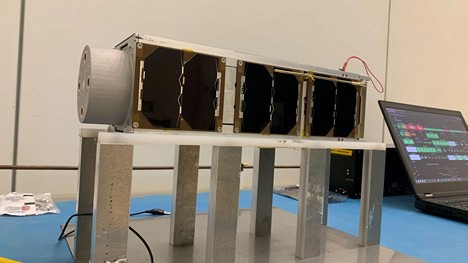GreenCube is based on closed-cycle hydroponics and is equipped with specific lighting, temperature, and humidity control systems to meet the restrictive requirements of spatial environments. GreenCube is capable of guaranteeing a complete growth cycle of micro-vegetables (cress, in this case) selected among the most suitable to endure extreme conditions and high productivity.
 At the ENEA Casaccia cytogenomic laboratory, researchers analyze plants after a growth test in the cubesat. In the photo: the base and plantlet in the hand of a researcher
At the ENEA Casaccia cytogenomic laboratory, researchers analyze plants after a growth test in the cubesat. In the photo: the base and plantlet in the hand of a researcher "Scientific research is focusing more and more on the development of bioregenerative systems to support life in extreme environments where cultivating in the open air is substantially impossible. Plants have a key role in precision nutrition, developed to integrate the diet of astronauts in space. The solutions thought up to supply fresh food to astronauts are then applied also to everyday agriculture as, in the future, it may have to be integrated with domestic production systems."
"Scientific research is focusing more and more on the development of bioregenerative systems to support life in extreme environments where cultivating in the open air is substantially impossible. Plants have a key role in precision nutrition, developed to integrate the diet of astronauts in space. The solutions thought up to supply fresh food to astronauts are then applied also to everyday agriculture as, in the future, it may have to be integrated with domestic production systems."
GreenCube is the first space garden experiment, launched in July with the maiden flight of new vector VEGA-C by the European Space Agency (ESA) from the Kourou base (French Guiana) together with scientific satellite "LARES2" and other five nano-satellites.
The micro-garden, which measures 30 x 10 x 10 cm, was designed by an all-Italian scientific team set up thanks to a collaboration agreement between the Italian Space Agency (ASI) and La Sapienza University in Rome and which also sees the participation of ENEA and Federico II University in Naples.
"Small soil-less cultivation systems like GreenCube could play a key role in satisfying the food needs of the crew, minimize operational times and avoid contamination thanks to the automated control of environmental conditions. Set in a pressurized and bounded environment, GreenCube is also equipped with a hi-tech sensor system for the remote monitoring of environmental, growth, and health condition parameters and independently transmits all the acquired data to Earth. The cultivation system enables maximized efficiency in terms of both volumes and consumption of energy, air, water, and nutrients. During the mission, experiments with crops in the soil will also be carried out in an exact copy of the satellite to verify the effects of radiation, low pressure, and microgravity on plants."
 The GREENCube satellite, boasting a cylindrical shape and a size of 10 x 10 x 30 cm, made of aluminum. Photovoltaic panels are placed along the walls to feed the management system and sensors.
The GREENCube satellite, boasting a cylindrical shape and a size of 10 x 10 x 30 cm, made of aluminum. Photovoltaic panels are placed along the walls to feed the management system and sensors.
"The data we are receiving is extremely interesting to also understand how to improve intensive agriculture and make it more precise by rationalizing the consumption of energy, fertilizers, water, etc. We could even grow the necessary vegetables at home, practically on demand, so based on our nutritional requirements according to weight and height parameters, etc., but also based on specific genetic characteristics."
"With climate change making open-air cultivation increasingly difficult, urban farming or domestic farming may help integrate intensive cultivation. Just think that it will also be possible to grow produce in the most difficult areas of the planet (deserts, high altitudes, arctic areas). Future applications aside, our research focuses a lot on technological innovation applicable to modern agriculture. Solutions against food waste and at the service of the production segment are born from experiments such as this one as it is estimated that, over the next few years, we will have to feed a planet inhabited by 10 billion people."
For further information: ![]()
Luca Nardi
ENEA
Laboratorio Biotecnologie
luca.nardi@enea.it
